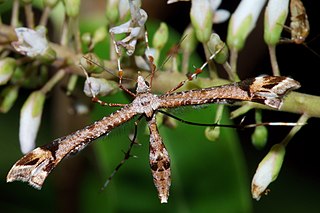
Amblyptilia falcatalis, the common Hebe plume moth, is a species of moth of the family Pterophoridae. This species was first described by Francis Walker and is endemic to New Zealand. This species can be found in both the North and South Islands. The larval host plants are in the Veronica genus and include Veronica stricta,Veronica salicifolia,Veronica elliptica, Veronica macrocarpa and Veronica speciosa. This moth likely has two broods a year and adults have been observed all year round.

Stigmella cypracma is a species of moth of the family Nepticulidae. It is endemic to New Zealand and has been observed in the North and South Islands. The larvae of this species are leaf miners and pupate within their mines. The larval host species is Brachyglottis repanda. Adult moths are on the wing in February and September to November. This species has two generations per year.

Stigmella fulva is a moth of the family Nepticulidae. It is endemic to New Zealand and has been observed in the North Island around Mount Taranaki, in the South Island and at Stewart Island. The species' eggs are laid singly but a considerable number may be deposited on the upper surface of one leaf. The incubation period can last from a week to a month depending on climatic conditions. The larvae mine the leaves of their host plants which are all in the genus Olearia. Larvae have been recorded in all months except January, February and June. The cocoon is brown and spun amongst the leaf litter under its host plant. The pupal period has been shown to range from 21 days to 79 days, again depending on climatic conditions. Adults have been observed on the wing January until March and August to December. They are active in the sun about their larval food plant.
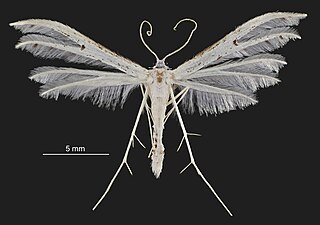
Pterophorus monospilalis, the white plume moth, is a moth of the family Pterophoridae. It is endemic to New Zealand and occurs throughout the country. It inhabits native forest, parks and domestic gardens. Larvae are active during the day, are slow moving, and feed exposed. They feed on Araliaceae species as well as on Hedera helix, Meryta sinclairii, and Schefflera digitata. There are several broods in a year. Adult moths are on the wing from November until May and are attracted to light.
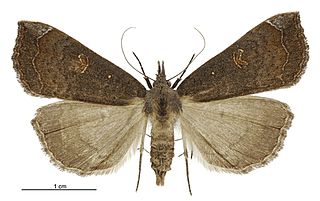
Rhapsa scotosialis, the slender owlet moth, is a moth of the family Noctuidae. This species is endemic to New Zealand and is found throughout the country. It is regarded as one of the most common forest moths found in New Zealand. The larval host species for R. scotosialis is Piper excelsum.

Pyrrosia eleagnifolia, commonly known as the leather-leaf fern, or ota in Māori, is a climbing fern endemic to New Zealand. P. eleagnifolia has thick, fleshy rounded leaves, and grows both on the ground and as an epiphyte.
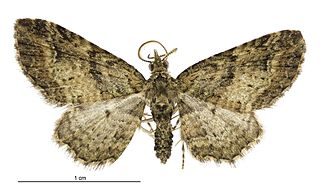
Pasiphila charybdis is a species of moth in the family Geometridae. It is endemic to New Zealand.

Epiphryne undosata, also known as the lacebark looper, is a moth of the family Geometridae. It is endemic to New Zealand and is found on both the North and South Islands. It inhabits native forest. The larvae feed on plant species in the genera Hoheria and Plagianthus. They pupate amongst dead leaves in a silk cocoon. The adult moths have been observed on the wing all year round but are most commonly seen from November until February. The adult moths are extremely variable in both their colour intensity and wing pattern.
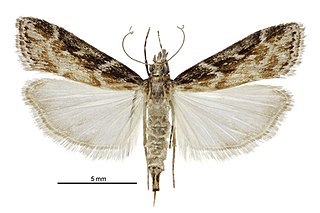
Scoparia molifera, also known as the leather-leaf Scoparia, is a species of moth of the family Crambidae. This species was first described by Edward Meyrick in 1926 and is endemic to New Zealand. It can be found in the North and South Islands. The larvae of this species make silk tunnels from which they mine the leaves of their host, the leather-leaf fern Pyrrosia eleagnifolia. Adult moths are on wing from December to February and are attracted to light.

Charixena iridoxa, also known as the Astelia zig-zag moth, is a moth of the family Plutellidae. It was first described by Edward Meyrick in 1916. This species is endemic to New Zealand and has been observed in the North, South and Stewart Islands. The life cycle of this moth is at least two years in length with the larvae inhabiting the bulb of its host plants and mining the underside of its leaves. These mines have a distinctive zig-zag appearance and can be easily recognised when looked for on the host plants. The larvae pupate in a cocoon attached to the leaf and this stage takes place between February and August. The adult moths emerge in the early spring and are fast, day flying moths. Their larval hosts are plants in the genus Astelia and include Astelia fragrans and Astelia nervosa.

Apoctena taipana is a species of moth of the family Tortricidae. It is endemic to New Zealand and has been observed in both the North and South Islands. The larvae created a silken tube in which they hide and also use to travel from leaf to leaf. They tunnel into the leaves of their host. Larvae can be found from June to August. Adult moths can be seen on the wing from October to January.

Eudonia zophochlaena is a moth in the family Crambidae. It was described by Edward Meyrick in 1923. It is endemic to New Zealand. It has been hypothesised that this species is a North Island endemic. The adults of this species are on the wing from December until February. The larvae of this species are leaf miners of the leather-leaf fern Pyrrosia eleagnifolia.

Thiotricha oleariae is a moth of the family Gelechiidae. It is endemic to in New Zealand, where it has been recorded from the central part of the North Island south down to Stewart Island. The species is found at altitudes of between sea-level up to 900 metres. The larvae live in a constructed case, are leaf miners and are active in November. The larval host species are within in the genus Olearia. Adults are nocturnal and on the wing from November to March.

Zapyrastra calliphana is a species of moth of the family Momphidae. It was first described by Edward Meyrick in 1889. It is found throughout New Zealand including at the Manawatāwhi / Three Kings Islands as well as at the Norfolk Islands. The preferred habitat of this species are native forest clearings, shrubland or coastal habitat such as scrub or dunes. The larvae of this species are leaf miners and are hosted by Muehlenbeckia species. There are likely several generations during the New Zealand summer and one generation overwinters as pupae. This species is a day flying moth and adults can be observed on the wing from October to March.

Proteodes carnifex is a species of moth in the family Depressariidae. It is endemic to New Zealand. Both the larvae and the adults of this species are variable in appearance. However the adults are normally easily identified as the outline is characteristic and the size is consistent. In appearance, adult moths mimic the leaves of their larval host plants. This species has been found near Wellington in the North Island, the tableland of Mount Arthur, in the Canterbury region, Arthur's Pass and at Lake Wakatipu in the South Island. The larval hosts of this species are southern beech trees, particularly black beech and mountain beech but larvae have also been found on Nothofagus fusca, Nothofagus truncata and Nothofagus menziesii. The female moth deposits her eggs individually on the underside of native beech tree leaves. Once hatched the larvae feed on those leaves through winter and spring and then pupate in January. The adult moth emerges from the pupa after fourteen days and is on the wing from January until April. They are day flying moths and are not attracted to light. Various insects parasitise the larvae of this moth including several species of wasp as well as flies including the endemic fly, Pales funesta.

Tortrix fervida is a species of moth of the family Tortricidae. It is endemic to New Zealand and has been observed in both the North and South Islands. The larvae feed on species of fern in the genus Hymenophyllum including Hymenophyllum nephrophyllum. The adult moths are variable in appearance and are day flying. They are on the wing from November until January. This species is regarded as being uncommon.

Chalastra aristarcha, the silver fern moth, is a moth of the family Geometridae. This species was first described by Edward Meyrick in 1892. It is endemic to New Zealand and is found in the North Island. This species inhabits dense native forest. The larvae feed on the species host plant, the Silver fern, during spring. This species then pupates on top of leaf litter or moss on the ground. The pupation state lasts for approximately 6 weeks. Adult moths are on the wing from October until April but can sometimes also be seen during the winter months. Adults can be disturbed from silver ferns during the day or are seen on the wing at night particularly at Metrosideros perforata when in flower. Adults are attracted to light. It has been hypothesised that the range of C. aristarcha has restricted as a result of urban development and land conversion of its habitat.

Pseudocoremia lupinata is a species of moth in the family Geometridae. It is endemic to New Zealand and can be found in both the North and South Islands. The favoured habitat of this species is Kānuka scrubland as its larval hosts are species in the genus Kunzea. Both the larvae and adults of this species are nocturnal. Adult moths are commonly on the wing from December to June and are attracted to light.
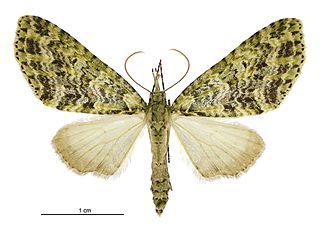
Tatosoma tipulata, also known as the kāmahi green spindle, is a species of moth in the family Geometridae. It was first described by Francis Walker in 1862. It is endemic to New Zealand and occurs in the North, South and Stewart Islands. This species inhabits native bush. The larvae have been recorded as feeding on Pterophylla racemosa, Nothofagus cliffortioides and Podocarpus totara. Adult moths are most commonly observed on the wing from September until March. Adults are nocturnal and are slightly attracted to light. They have also been collected via sugar traps. During the day adults can often be observed resting, camouflaged against moss and lichens, on the trunks of trees.
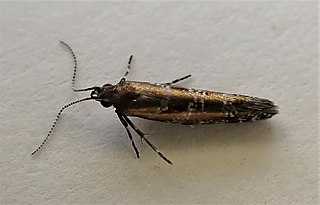
Chrysorthenches drosochalca is a species of moth in the family Plutellidae first described by Edward Meyrick in 1905. It is endemic to New Zealand and has been found in the North and South Islands. The larvae are leaf miners of Prumnopitys ferruginea. Adults are on the wing from January to March.























